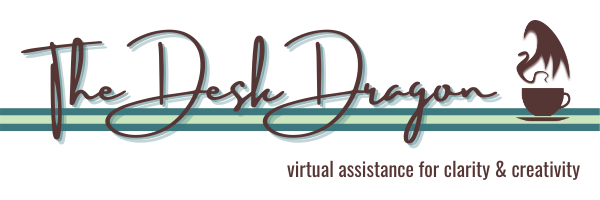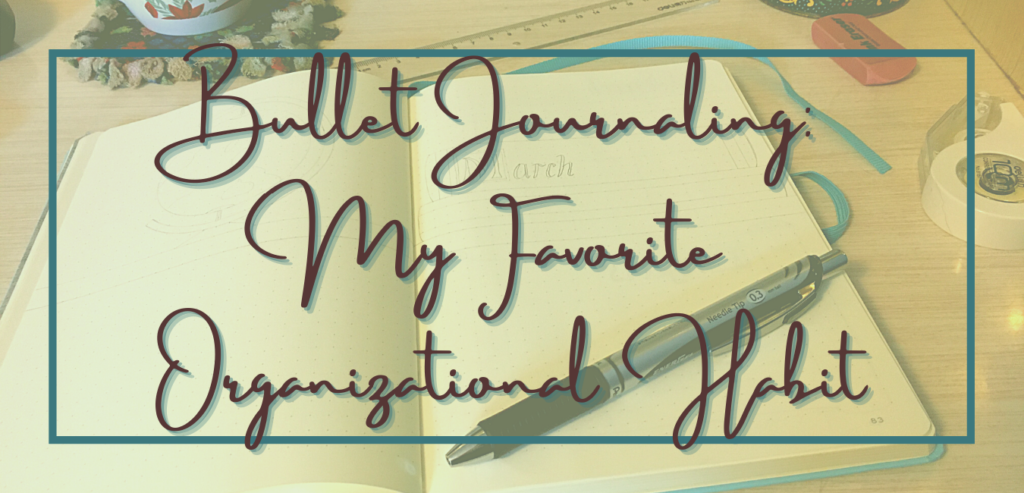If I had to credit a single habit with keeping me at my most organized and sane, it would have to be bullet journaling. I call it a habit because I’ve made a point of spending time on it every day, but it is of course much more than just a habit. (More on that later.)
What Is a Bullet Journal?
The original system, created by Ryder Carroll, uses bullet-point lists, quick note-taking, and regular review to maintain focus and productivity. You can read about Carroll’s methods on his website, or check out his book. But the beauty of a bullet journal is that the basic system can be adapted in a myriad of ways to suit each individual’s particular needs and preferences. A bullet journal is a planner, a calendar, a journal, and anything else you might choose to make of it. It can be extremely minimalist and require nothing more than a pen and notebook, or it can be extremely artistic and involve a plethora of colorful supplies. Most are probably somewhere in between.
Why I Started Bullet Journaling — and Why I Continue
I first started bullet journaling at the beginning of 2017. I had been working on establishing a number of personal habits, and was looking for a system that would help me stick to those habits. One of those habits happened to be journaling every day (instead of once every few months), so it made sense to have everything — journal entries, habit trackers, calendar, checklists, etc. — all in one place that I would be checking on a daily basis.
Another thing that drew me to bullet journaling was the creative avenue it allowed within its structure. I’ve written before about my love of to-do lists and schedules and how I learned to find a balance between structure and flexibility. Bullet journaling is the perfect system for me in that I can be both structured and creative.
With the help of my bullet journal, I have been able to establish and stick to my own routines, habits, and yes — finally start journaling every single day. It also helps me keep a record of how I spend my time and preserve memories I might otherwise forget. And it makes reflecting on personal growth and progress super easy.
My Planning Process
Everyone who keeps a bullet journal has their own unique system for planning and reflection. Mine consists of these basic parts:
Monthly Pages
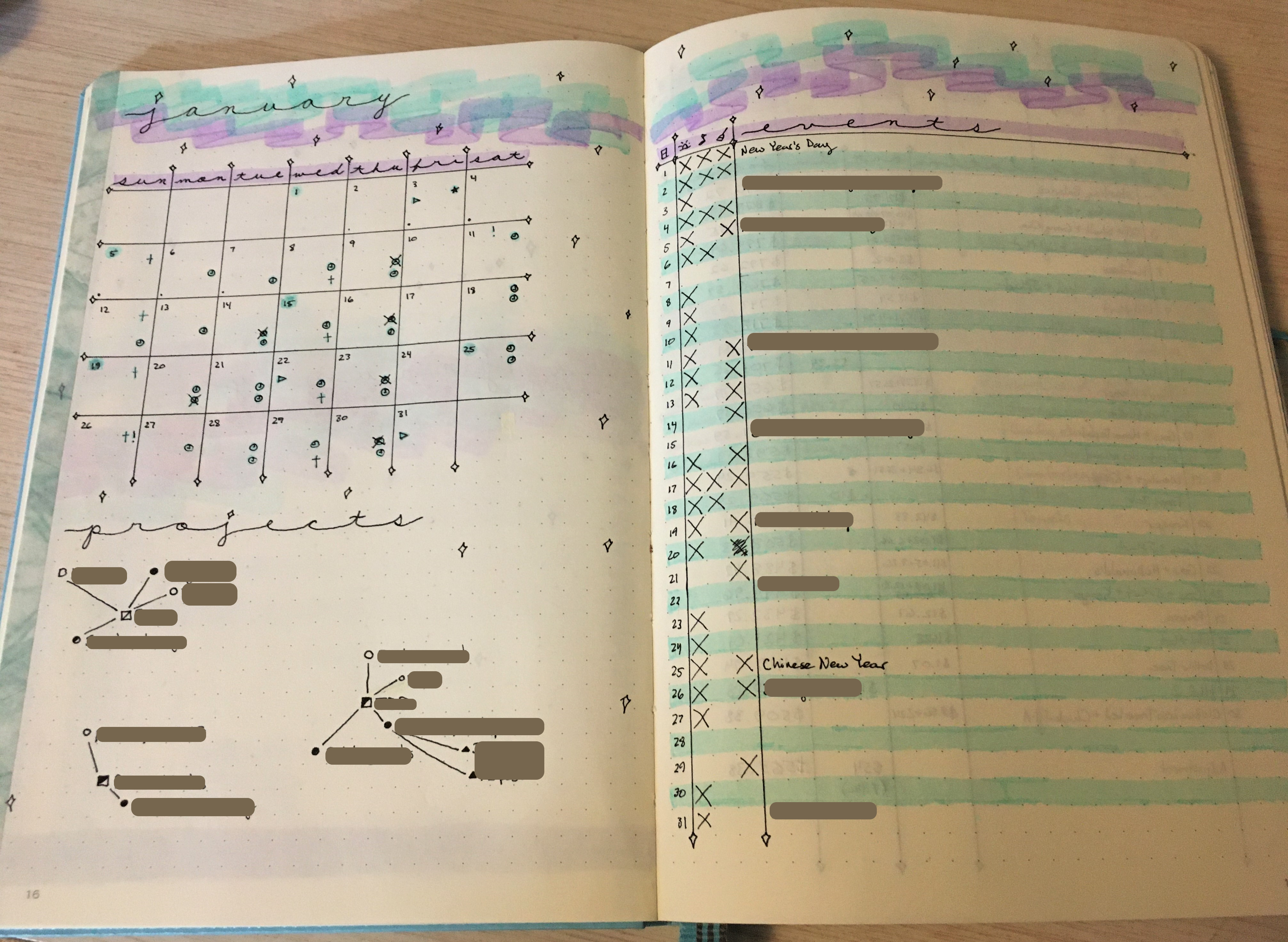
Ryder Carroll’s system simply lists the dates of the month in a column down the page, but I find I need to see the calendar laid out more traditionally. I I do like the column method, however, so I’ve adapted it a bit to suit my preferences.
On the left-hand page, I draw out my calendar, and underneath it leave space for “Projects,” which are the major goals I have for the month, broken down into steps (marked out in the photo for privacy). To keep my calendar looking less crowded, I like to use symbols for events, holidays, etc., and then list them in more detail in the columns on the right-hand page. I also keep track of habits in those columns, because that way I don’t have to write out the dates yet another time or draw extra boxes.
I also include a page at the beginning of each month to keep track of finances: income, spending, budgets, etc. I’m constantly tweaking this one to best accomplish what I need it to.
And at the end of the month I take time to review and reflect on accomplishments, improvements to make, and general highlights.
Weekly Pages
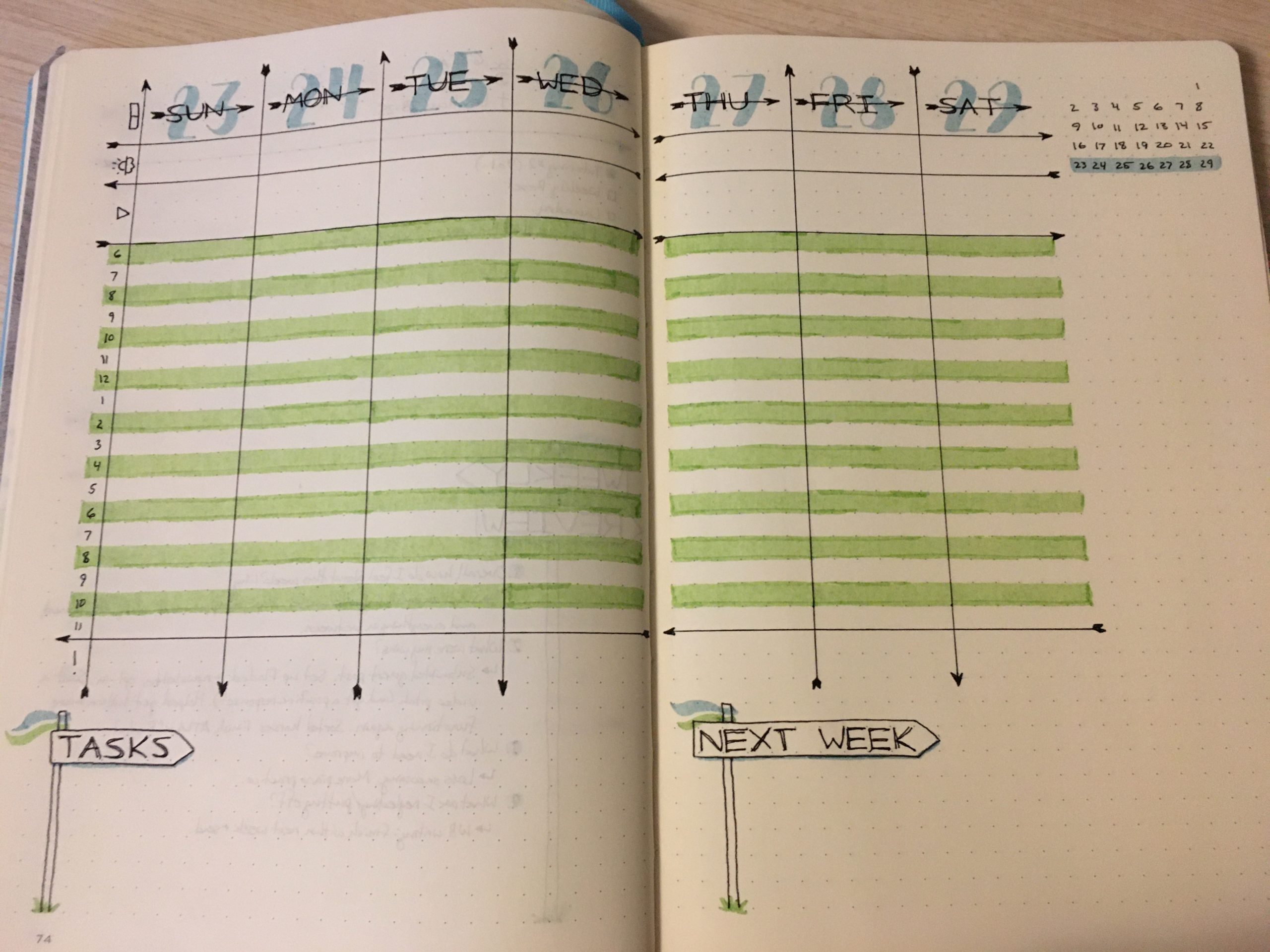
I tend to change this one up at least every few months, depending on my schedule. Just like the monthly page, however, I prefer to see the days laid out in a calendar-like format so I can see roughly what days and times I have things scheduled.
The layout I currently use is my favorite so far because of how I incorporated the timetable, but even if I don’t have the days set up hour-by-hour, I tend to place activities and appointments in such a way that I can tell at a glance which are scheduled for morning, afternoon, and evening.
At the end of the week, I also set aside a half-page for a weekly review. This allows me to assess the previous week and prepare for the next.
Daily Pages
This might be where I differ the most from a lot of bullet journalers. Most people I’ve seen online use either a weekly layout OR daily pages, but I’ve found I really like having both. I use the weekly pages to plan ahead and see the whole week’s schedule at a glance. And I use the daily pages to organize my thoughts in the morning and to journal. There’s something about starting the day on a literal blank page that helps me feel more organized and refreshed, but I do need to have a place to write out plans and schedules before the day of.
The key that finally clicked into place and got me to journal every day was training myself to write at least one sentence here in the morning, right after I make my to-do list for the day, and then at least one more sentence under that at night before I go to bed. Sometimes these are lists of things that happened that day; sometimes they’re notes about what’s on my mind; sometimes they’re simply a line about not knowing what to write — but in any case, they’re words on the paper, every day.
At first, I tried using a color code or symbols for the topic of writing (reflection, a story about the day’s events, etc.), but simplifying it to just morning thoughts and evening thoughts, notated with an arrow up and arrow down, respectively, makes it much easier for me to just get it out of my head and onto the page.
Collections
A collection is a fully customized page for anything outside of the monthly, weekly, and daily pages. The possibilities are endless, but so is the potential to create collections that end up being forgotten or not filled up.
Inevitably, I end up with a few collections scattered between the months and weeks, but I like to keep most of them in a section at the front of the journal, so they’re easy to find.
Note: most bullet journals, following Ryder Carroll’s example, use a key to keep symbols straight and an index for ease of locating pages. I always use the same symbols and kept forgetting to make the key in the first place, so I’ve stopped using that one altogether. I like to have an index so I can find certain pages in past journals, but sometimes I don’t fill it out until I archive that journal and move into the next one.
My current favorite collections include the following:
6-Month Future Log and 6-Month Goals
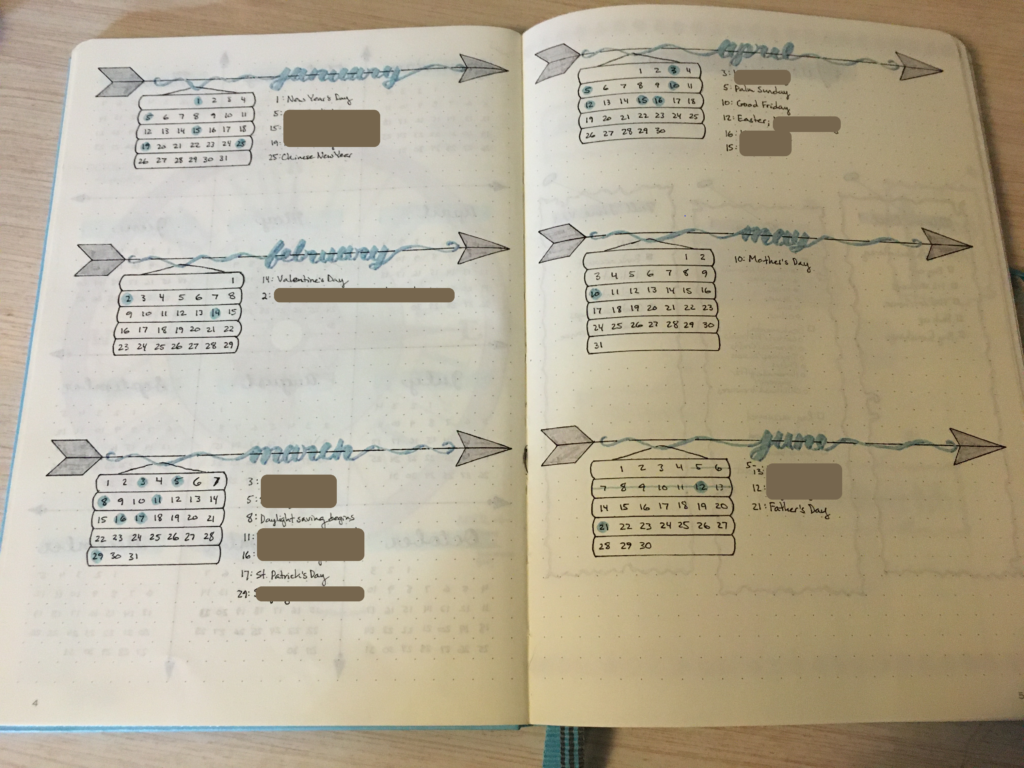
The purpose of the Future Log is to write down important dates that will occur later than the current month, since each monthly calendar usually isn’t drawn out until we arrive at that month. Many people make a Future Log for the entire year, but my journals never last longer than six months, so the same goes for my Future Log.
For the same reason, I like to set goals for the next 6 months, rather than the entire year. I’ve found it also makes it easier to meet these goals, because I have to make them attainable within a shorter period of time.
Quotes Pages
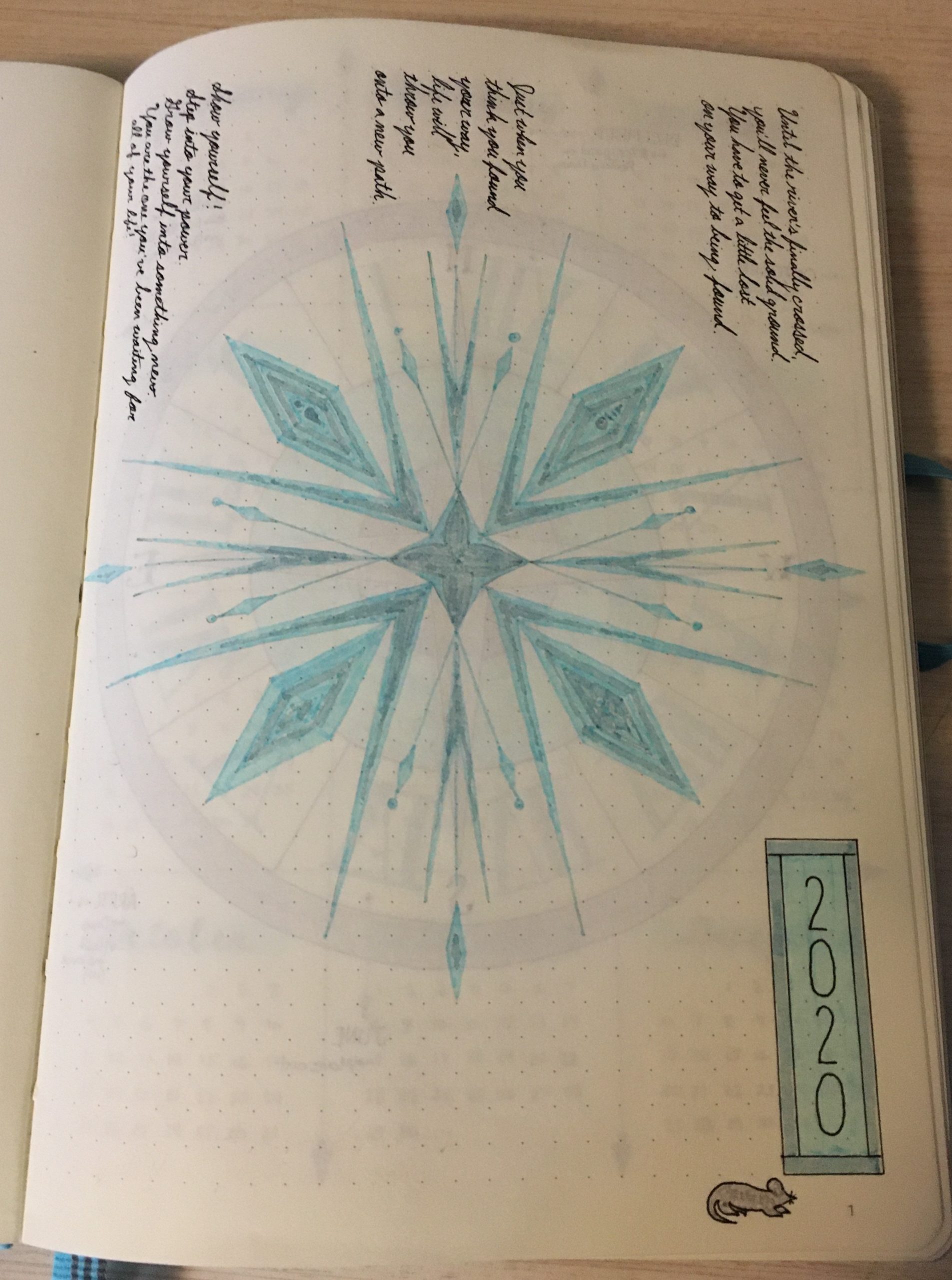
I often start with a cover page of sorts, with either a quote or an illustration (or both) to signify the start of a new 6-month period. At the beginning of this year, I was (okay, I still am) totally in love with Frozen II, so I designed the cover page after that theme. And I like to include the Chinese zodiac symbol for the year, so I had fun incorporating the rat into this page as well. (Fun fact: the rat is the first animal in the 12-year rotation, so it signifies a new beginning. I thought that was extra fitting for the start of a new decade!)
In addition to the cover page, I’ve developed a page of mantras: quotes that are especially meaningful or that I want to make more of an effort to live by. Most of these stay the same from journal to journal, but sometimes I’ll add a new one or take one out as my circumstance change.
Other Collections
Other collections I often or always use include a log of what I’m watching on TV, a tracker for tasks that occur every few weeks or months, and additional finance pages.
How Bullet Journaling Helps Me
As I mentioned above, bullet journaling helps me stay organized and remember important information. It also gives me a creative outlet and a way to both start and end my day in a mindful and quiet manner. I notice a definite feeling of being less on top of things when I let myself fall behind, and a much greater sense of self-awareness and productivity when I keep up with it.
Furthermore, it’s also taught me to have more grace for myself instead of insisting on making everything perfect. I can either spend way too much time making every line exact and tear out pages when I make mistakes, or I can accept that it doesn’t have to be flawless — it just has to be functional. And sometimes those “mistakes” add an unexpected element of beauty that I would never have discovered otherwise.
Have you tried bullet journaling? How was your experience? What systems do you use to stay organized? I’d love to hear from you.
Did you know?
I offer writing & editing, podcast production, and virtual admin services.
Click here to see how I can help you get more time back in your day!
